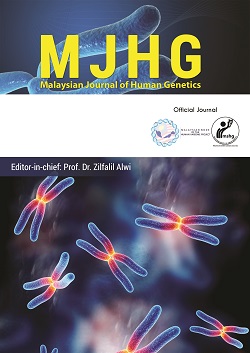Quantitative Insights into Microbial Ecology software allows the dissection of oral microbial diversity
Keywords:
Metagenomic Analysis, open-reference Operational taxonomic units (OTU), Quantitative insights into microbial ecology (QIIME), taxonomyAbstract
Objective: Recent approach based on the 16S rRNA gene sequence, which bypasses the need for culturing was being used to assess the diversity and relative abundance of bacteria in the carious patients. Here, we report the use of 16S rRNA V3-V4 marker gene approach to dissect the oral microbial diversity in patients’ caries. Methods: A total of 8 subjects with caries aged between 20-30 years old from Dental Clinic, Hospital Universiti Sains Malaysia, Kelantan were recruited. The DNA from collected plaque samples were examined by high-throughput sequencing of the V3-V4 hypervariable region of the 16S rRNA gene using MiSeq sequencing platform. For 16S rRNA amplicon analysis, the Quantitative Insights into Microbial Ecology (QIIME) programme was utilised and the Greengenes database was used for taxonomy classification. Results: By using this platform, we identified six top communities of microbial in the caries samples. Protobacteria OTUs were most dominant in all samples with abundance value of (47.4%), followed by Firmicutes (21%), Bacteroidetes (15.6%), Actinobacteria (7.5%) and Fusobacteria (5.2%) and TM7 (3.2%). Conclusion: The QIIME is a robust platform that is able to support a wide range of microbial community analyses and to classify the oral microbial taxa in the taxonomic hierarchy i.e. from kingdom, phylum, class, order, family, genus to species level.
Downloads
References
Aas, J. A., Paster, B. J., Stokes, L. N., Olsen, I., & Dewhirst, F. E. (2005) ‘Defining the normal bacterial flora of the oral cavity’, Journal of Clinical Microbiology, 43(11), pp. 5721–5732. doi: 10.1128/JCM.43.11.5721-5732.2005.
Ahn, J., Yang, L., Paster, B. J., Ganly, I., Morris, L., Pei, Z., & Hayes, R. B. (2011) ‘Oral microbiome profiles: 16s rRNA pyrosequencing and microarray assay comparison’, PLoS ONE, 6(7), pp. 1–6. doi: 10.1371/journal.pone.0022788.
Bennett, K. W. and Eley, A. (1993) ‘Fusobacteria: New taxonomy and related diseases’, Journal of Medical Microbiology, 39(4), pp. 246–254. doi: 10.1099/00222615-39-4-246.
Bik, E. M., Long, C. D., Armitage, G. C., Loomer, P., Emerson, J., Mongodin, E. F., Nelson, K. E., Gill, S. R., Fraser-Liggett, C. M., & Relman, D. A. (2010) ‘Bacterial diversity in the oral cavity of 10 healthy individuals’, ISME Journal, 4(8), pp. 962–974. doi: 10.1038/ismej.2010.30.
Chakravorty, S., Helb, D., Burday, M., & Connell, N. (2007) ‘A detailed analysis of 16S ribosomal RNA gene segments for the diagnosis of pathogenic bacteria’, J Microbiol Methods., 69(2), pp. 330–339. doi: 10.1016/j.mimet.2007.02.005.A.
Chaudhary, N., Sharma, A. K., Agarwal, P., Gupta, A., & Sharma, V. K. (2015) ‘16S classifier: A tool for fast and accurate taxonomic classification of 16S rRNA hypervariable regions in metagenomic datasets’, PLoS ONE, 10(2), pp. 1–13. doi: 10.1371/journal.pone.0116106.
Dewhirst, F. E., Chen, T., Izard, J., Paster, B. J., Tanner, A. C. R., Yu, W. H., Lakshmanan, A., & Wade, W. G. (2010) ‘The human oral microbiome’, Journal of Bacteriology, 192(19), pp. 5002–5017. doi: 10.1128/JB.00542-10.
Graspeuntner, S., Loeper, N., Künzel, S., Baines, J. F., & Rupp, J. (2018) ‘Selection of validated hypervariable regions is crucial in 16S-based microbiota studies of the female genital tract’, Scientific Reports, (June), pp. 4–10. doi: 10.1038/s41598-018-27757-8.
Jiang, Q., Liu, J., Chen, L., Gan, N., & Yang, D. (2019) ‘The oral microbiome in the elderly with dental caries and health’, Frontiers in Cellular and Infection Microbiology, 9(JAN). doi: 10.3389/fcimb.2018.00442.
Peterson, S. N., Snesrud, E., Liu, J., Ong, A. C., Kilian, M., Schork, N. J., & Bretz, W. (2013) ‘The Dental Plaque Microbiome in Health and Disease’, PLoS ONE, 8(3). doi: 10.1371/journal.pone.0058487.
Rajilić-Stojanović, M. and de Vos, W. M. (2014) ‘The first 1000 cultured species of the human gastrointestinal microbiota’, FEMS Microbiology Reviews, 38(5), pp. 996–1047. doi: 10.1111/1574-6976.12075.
Ventura, M., Canchaya, C., Tauch, A., Chandra, G., Fitzgerald, G. F., Chater, K. F., & van Sinderen, D. (2007) ‘Genomics of Actinobacteria: Tracing the Evolutionary History of an Ancient Phylum’, Microbiology and Molecular Biology Reviews, 71(3), pp. 495–548. doi: 10.1128/mmbr.00005-07.
Downloads
Published
Issue
Section
License
Copyright (c) 2024 Malaysian Journal of Human Genetics

This work is licensed under a Creative Commons Attribution 4.0 International License.


